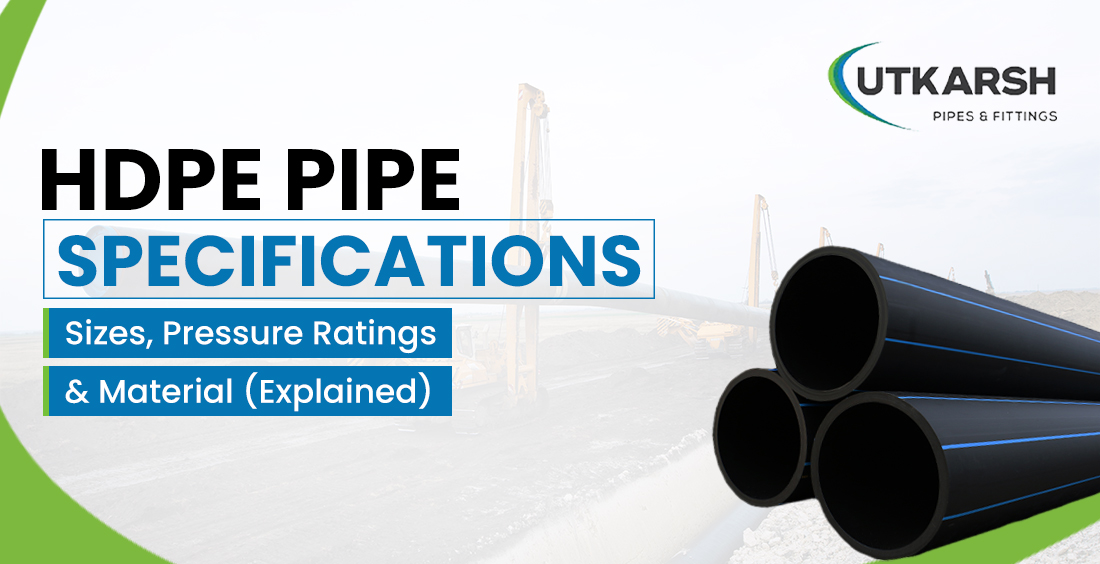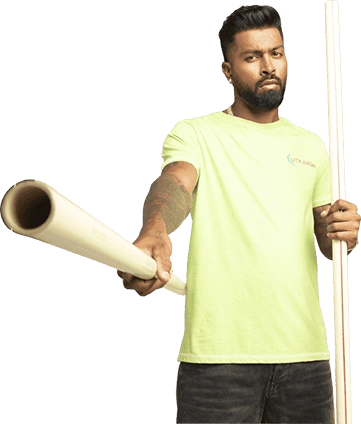HDPE Pipe Specifications: Sizes, Pressure Ratings & Material (Explained)

If you are working on a large-scale municipal, industrial, or agricultural project, you might have come across the question, “What is HDPE pipe?” It’s because the HDPE pipes & fittings are omnipresent today ranging from irrigation systems to wastewater systems because of their outstanding strength and versatility alongside cost effectiveness.
In today's blog, we will try to answer the question, “what is HDPE pipe specifications”, sizes, pressure ratings and material composition in actionable words. We will also explain how to choose the right HDPE pipes & fittings for your projects, and discuss what makes these pipes so revolutionary.
What is HDPE Pipe?
The acronym HDPE stands for High-Density Polyethylene which is a type of thermoplastic characterized by a high strength-to-density ratio. By now we have understood the question, “What is HDPE pipe,” right? It is a durable thermoplastic pipe that is constructed to safely transport various fluids under different temperatures and pressures as well as environmental conditions without risks of corrosion, rust, and streaks.
HDPE pipes & fittings are integrated in nearly every section of the economy including but not limited to water supply and sewerage systems, chemical transportation, and even mining. Their flexibility, prolonged life expectancy, and resistance to extreme conditions are the core reasons why they are the most preferable option in different industries.
Know more: What are the environmental benefits of using HDPE pipes?
Key HDPE Pipe Specifications You Should Know
Let’s dive deep into what is HDPE pipe specifications so you can make better, informed decisions:
1. Available Sizes and Diameters
HDPE pipes have varying sizes to serve different purposes:
Available sizes range: 20 mm to 1200 mm, but some manufacturers offer bigger sizes.
Diameter of Wall: Changes based on the pressure rating and diameter.
Pre-defined Lengths: Ready made lengths of standard 6 and 12 meters long, or in coils with smaller diameters.
Actionable Tip: Use a pipe with a diameter between 20 mm and 110 mm if working on a small irrigation or plumbing works. Use bigger diameters above 250 mm for municipal water supply or industrial pipelines where high water flow is needed.
2. Pressure Ratings (PN Ratings)
Pressure ratings indicate how much internal pressure a pipe can handle. HDPE pipes are usually categorized under:
PN 4 to PN 16: Measured in bar, covering low to high-pressure applications.
For example:
PN 6: Suitable for gravity-fed systems like irrigation.
PN 10 & PN 12.5: Commonly used for water supply and industrial pipelines.
PN 16: Ideal for high-pressure lines, including firefighting systems.
Actionable Tip: Before selecting HDPE pipes & fittings, always calculate the maximum pressure your system will face. It ensures safety, reduces wear and tear, and prolongs the life of the pipe.
3. Material Grade: PE 63, PE 80 & PE 100
Material grade affects the strength and durability of the pipe:
PE 63: Suitable for low-pressure systems.
PE 80: Offers better strength, commonly used in water supply.
PE 100: High strength, can handle high-pressure applications like gas lines.
Actionable Tip: Opt for PE 100 material grade if you’re working on heavy-duty infrastructure or projects exposed to tough environmental conditions.
4. Temperature Resistance
HDPE pipes can function effectively in a wide temperature range:
Minimum Temperature: -40°C (great for cold regions).
Maximum Operating Temperature: Around 60°C.
This feature makes HDPE pipes ideal for both hot and cold climates.
Advantages of HDPE Pipes & Fittings
Why are HDPE pipes & fittings preferred over conventional pipes like steel, concrete, or PVC?
Corrosion Resistance: No rusting or degradation.
Lightweight & Flexible: Easier handling and installation.
Leak-Proof Joints: Fused joints reduce the risk of leakage.
Chemical Resistance: Suitable for transporting chemicals, gases, and slurries.
Long Service Life: 50+ years with minimal maintenance.
Actionable Tip: To save long-term maintenance costs, always invest in HDPE pipes & fittings, especially for underground or remote projects where frequent repairs can be costly.
Check this out: Comparing HDPE Pipes with Steel and Concrete Pipes for Industrial Use
Quick Guide: How to Choose the Right HDPE Pipe
Here’s a simple checklist you can follow:
Identify Your Application: Water supply, sewage, chemicals, irrigation, etc.
Determine Required Diameter: Match flow rate needs.
Check Pressure Rating: Based on internal pressure.
Select Material Grade: PE 63, PE 80, or PE 100 depending on strength needs.
Review Temperature and Chemical Resistance: Especially if transporting industrial fluids.
Where to Source High-Quality HDPE Pipes & Fittings?
At this point, if you’re wondering where to get reliable HDPE pipes & fittings, Utkarsh Pipes & Fittings is a name you can trust. Utkarsh ranks among the top PVC HDPE pipe manufacturers in India. Designed as an efficient and cost-effective solution, their piping systems cater to a wide range of projects—whether it’s municipal, irrigation, treatment plants, mining, or industrial.
Their HDPE pipes are renowned for:
Smooth surface finish for seamless flow.
Anti-corrosion properties.
Strong mechanical strength.
Suitability across oil & gas, mining, chemical, and even hazardous waste transportation.
What’s more, we manufacture pipes that meet stringent quality standards, making them ideal for ground, surface, buried, and floating installations. Be it municipal or industrial infrastructure projects, we are your most trusted partner.
Conclusion
So, to wrap it up: What is HDPE pipe? It’s a versatile, durable, and cost-effective piping solution that works wonders across industries. Knowing what is HDPE pipe specifications, sizes, and pressure ratings can help you choose the right system for your specific needs. HDPE pipes & fittings offer unmatched performance, corrosion resistance, and long service life—all at a reasonable price.
FAQs:
What is the pressure rating of HDPE pipes?
The pressure rating of HDPE pipes typically ranges from PN 4 to PN 16, indicating their ability to handle 4 to 16 bar of internal pressure.
What is the pressure testing standard for HDPE pipe?
The pressure testing standard for HDPE pipe typically follows ISO 4427 and ASTM F2164, requiring hydrostatic pressure testing at 1.5 times the operating pressure for a specified duration to ensure pipe integrity and leak-free performance.
What is the strength of the HDPE pipe?
The strength of HDPE pipe lies in its high tensile strength and flexibility, typically ranging from 20 MPa to 37 MPa, making it durable and resistant to pressure, impact, and environmental stress.











